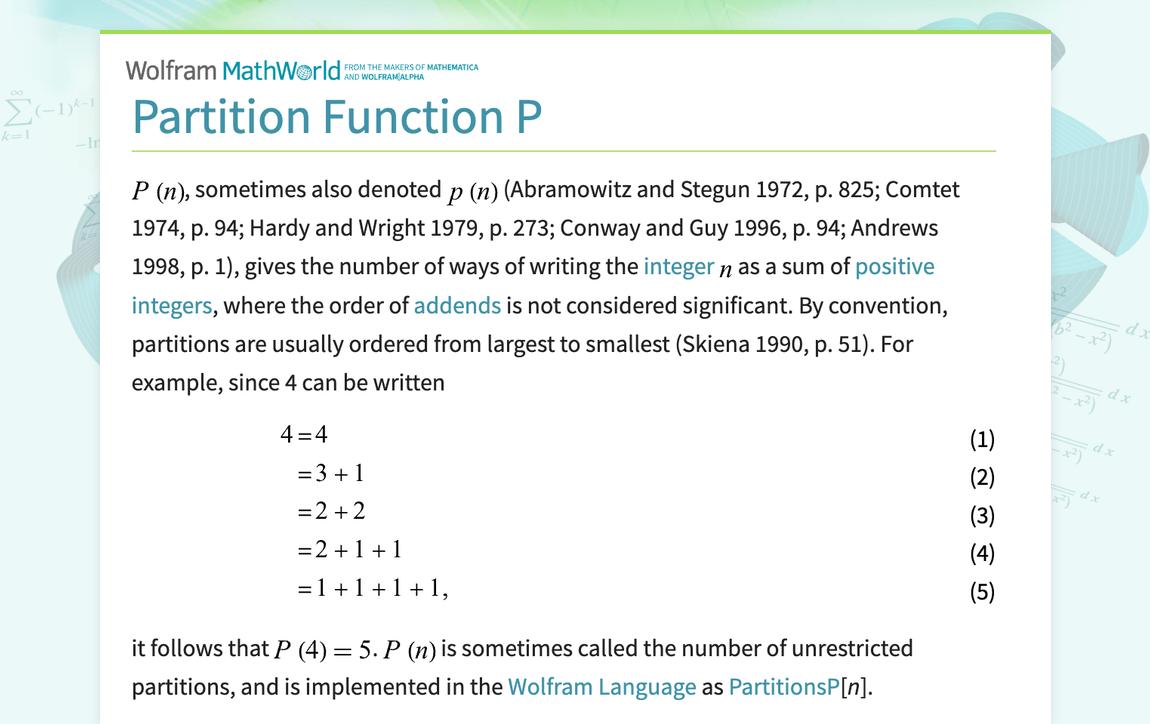
mathworld.wolfram.com/PartitionFunctionP.html
Preview meta tags from the mathworld.wolfram.com website.
Linked Hostnames
12- 70 links tomathworld.wolfram.com
- 18 links towww.amazon.com
- 11 links tooeis.org
- 5 links towww.wolfram.com
- 4 links towww.wolframalpha.com
- 2 links toreference.wolfram.com
- 1 link toarxiv.org
- 1 link tofunctions.wolfram.com
Thumbnail

Search Engine Appearance
Partition Function P -- from Wolfram MathWorld
P(n), sometimes also denoted p(n) (Abramowitz and Stegun 1972, p. 825; Comtet 1974, p. 94; Hardy and Wright 1979, p. 273; Conway and Guy 1996, p. 94; Andrews 1998, p. 1), gives the number of ways of writing the integer n as a sum of positive integers, where the order of addends is not considered significant. By convention, partitions are usually ordered from largest to smallest (Skiena 1990, p. 51). For example, since 4 can be written 4 = 4 (1) = 3+1 (2) = 2+2 (3) = 2+1+1 (4) =...
Bing
Partition Function P -- from Wolfram MathWorld
P(n), sometimes also denoted p(n) (Abramowitz and Stegun 1972, p. 825; Comtet 1974, p. 94; Hardy and Wright 1979, p. 273; Conway and Guy 1996, p. 94; Andrews 1998, p. 1), gives the number of ways of writing the integer n as a sum of positive integers, where the order of addends is not considered significant. By convention, partitions are usually ordered from largest to smallest (Skiena 1990, p. 51). For example, since 4 can be written 4 = 4 (1) = 3+1 (2) = 2+2 (3) = 2+1+1 (4) =...
DuckDuckGo
Partition Function P -- from Wolfram MathWorld
P(n), sometimes also denoted p(n) (Abramowitz and Stegun 1972, p. 825; Comtet 1974, p. 94; Hardy and Wright 1979, p. 273; Conway and Guy 1996, p. 94; Andrews 1998, p. 1), gives the number of ways of writing the integer n as a sum of positive integers, where the order of addends is not considered significant. By convention, partitions are usually ordered from largest to smallest (Skiena 1990, p. 51). For example, since 4 can be written 4 = 4 (1) = 3+1 (2) = 2+2 (3) = 2+1+1 (4) =...
General Meta Tags
43- titlePartition Function P -- from Wolfram MathWorld
- DC.TitlePartition Function P
- DC.CreatorWeisstein, Eric W.
- DC.DescriptionP(n), sometimes also denoted p(n) (Abramowitz and Stegun 1972, p. 825; Comtet 1974, p. 94; Hardy and Wright 1979, p. 273; Conway and Guy 1996, p. 94; Andrews 1998, p. 1), gives the number of ways of writing the integer n as a sum of positive integers, where the order of addends is not considered significant. By convention, partitions are usually ordered from largest to smallest (Skiena 1990, p. 51). For example, since 4 can be written 4 = 4 (1) = 3+1 (2) = 2+2 (3) = 2+1+1 (4) =...
- descriptionP(n), sometimes also denoted p(n) (Abramowitz and Stegun 1972, p. 825; Comtet 1974, p. 94; Hardy and Wright 1979, p. 273; Conway and Guy 1996, p. 94; Andrews 1998, p. 1), gives the number of ways of writing the integer n as a sum of positive integers, where the order of addends is not considered significant. By convention, partitions are usually ordered from largest to smallest (Skiena 1990, p. 51). For example, since 4 can be written 4 = 4 (1) = 3+1 (2) = 2+2 (3) = 2+1+1 (4) =...
Open Graph Meta Tags
5- og:imagehttps://mathworld.wolfram.com/images/socialmedia/share/ogimage_PartitionFunctionP.png
- og:urlhttps://mathworld.wolfram.com/PartitionFunctionP.html
- og:typewebsite
- og:titlePartition Function P -- from Wolfram MathWorld
- og:descriptionP(n), sometimes also denoted p(n) (Abramowitz and Stegun 1972, p. 825; Comtet 1974, p. 94; Hardy and Wright 1979, p. 273; Conway and Guy 1996, p. 94; Andrews 1998, p. 1), gives the number of ways of writing the integer n as a sum of positive integers, where the order of addends is not considered significant. By convention, partitions are usually ordered from largest to smallest (Skiena 1990, p. 51). For example, since 4 can be written 4 = 4 (1) = 3+1 (2) = 2+2 (3) = 2+1+1 (4) =...
Twitter Meta Tags
5- twitter:cardsummary_large_image
- twitter:site@WolframResearch
- twitter:titlePartition Function P -- from Wolfram MathWorld
- twitter:descriptionP(n), sometimes also denoted p(n) (Abramowitz and Stegun 1972, p. 825; Comtet 1974, p. 94; Hardy and Wright 1979, p. 273; Conway and Guy 1996, p. 94; Andrews 1998, p. 1), gives the number of ways of writing the integer n as a sum of positive integers, where the order of addends is not considered significant. By convention, partitions are usually ordered from largest to smallest (Skiena 1990, p. 51). For example, since 4 can be written 4 = 4 (1) = 3+1 (2) = 2+2 (3) = 2+1+1 (4) =...
- twitter:image:srchttps://mathworld.wolfram.com/images/socialmedia/share/ogimage_PartitionFunctionP.png
Link Tags
4- canonicalhttps://mathworld.wolfram.com/PartitionFunctionP.html
- preload//www.wolframcdn.com/fonts/source-sans-pro/1.0/global.css
- stylesheet/css/styles.css
- stylesheet/common/js/c2c/1.0/WolframC2CGui.css.en
Links
116- http://arxiv.org/abs/1104.1182
- http://functions.wolfram.com/IntegerFunctions/PartitionsP
- http://oeis.org/A000009
- http://oeis.org/A000041
- http://oeis.org/A000700